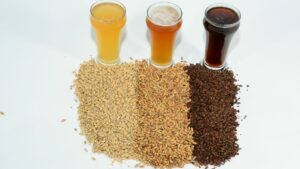 Exploring the world of homebrewing can be both exciting and rewarding for enthusiasts looking to craft their own delicious beverages. One essential aspect of this journey is understanding the intricacies of a home brewing setup diagram. This visual guide serves as a roadmap for brewers, outlining the equipment and steps required to create unique and flavorful concoctions in the comfort of their own space. By familiarizing oneself with a home brewing setup diagram, individuals can streamline their brewing process, optimize efficiency, and ensure consistency in their final products. From fermenters to airlocks, each component plays a crucial role in transforming raw ingredients into a delightful brew. Whether you’re a novice brewer or a seasoned pro, grasping the fundamentals of a home brewing setup diagram is key to mastering the art of crafting exceptional beverages at home.
Exploring the world of homebrewing can be both exciting and rewarding for enthusiasts looking to craft their own delicious beverages. One essential aspect of this journey is understanding the intricacies of a home brewing setup diagram. This visual guide serves as a roadmap for brewers, outlining the equipment and steps required to create unique and flavorful concoctions in the comfort of their own space. By familiarizing oneself with a home brewing setup diagram, individuals can streamline their brewing process, optimize efficiency, and ensure consistency in their final products. From fermenters to airlocks, each component plays a crucial role in transforming raw ingredients into a delightful brew. Whether you’re a novice brewer or a seasoned pro, grasping the fundamentals of a home brewing setup diagram is key to mastering the art of crafting exceptional beverages at home.
Home Brewing Setup Diagram
Understanding a home brewing setup diagram is crucial for both novice and experienced brewers. This visual representation outlines the essential equipment and processes required to brew beverages at home successfully. By familiarizing themselves with components like fermenters, airlocks, and bottling tools, individuals can streamline their brewing process, ensuring consistency and quality in their final products. Mastering the fundamentals of a home brewing setup is key to enhancing efficiency and enjoying a rewarding brewing experience.
Essential Components in Homebrewing
 Starting with the foundation of any great home brewing setup, understanding the mash tun is crucial. The mash tun is where the milled grains are combined with hot water to convert starches into fermentable sugars. It’s an essential component that sets the stage for the brewing process. Moving on to the pivotal step of boiling the wort, the boil kettle plays a vital role. This is where hops are added, flavors are developed, and the liquid is sterilized. An efficient boil kettle is necessary to achieve the desired flavors and characteristics in the final brew. By familiarizing oneself with a home brewing setup diagram, individuals can streamline their brewing process, optimize efficiency, and ensure consistency in their final products.
Starting with the foundation of any great home brewing setup, understanding the mash tun is crucial. The mash tun is where the milled grains are combined with hot water to convert starches into fermentable sugars. It’s an essential component that sets the stage for the brewing process. Moving on to the pivotal step of boiling the wort, the boil kettle plays a vital role. This is where hops are added, flavors are developed, and the liquid is sterilized. An efficient boil kettle is necessary to achieve the desired flavors and characteristics in the final brew. By familiarizing oneself with a home brewing setup diagram, individuals can streamline their brewing process, optimize efficiency, and ensure consistency in their final products.
Diagram of the Home Brewing Setup
 Exploring a home brewing setup diagram unveils the intricate process of crafting delightful beverages within the comfort of one’s abode. By comprehending this visual representation, both amateur and adept brewers can grasp the essential equipment and sequential procedures required to produce distinctive drinks. Understanding components like fermenters, airlocks, and bottling tools is pivotal in refining the brewing process to achieve consistent quality in the final concoctions. The foundation of home brewing lies in fundamental components, starting with the mash tun. Here, milled grains amalgamate with hot water to transform starches into fermentable sugars, laying the groundwork for flavorful brews.
Exploring a home brewing setup diagram unveils the intricate process of crafting delightful beverages within the comfort of one’s abode. By comprehending this visual representation, both amateur and adept brewers can grasp the essential equipment and sequential procedures required to produce distinctive drinks. Understanding components like fermenters, airlocks, and bottling tools is pivotal in refining the brewing process to achieve consistent quality in the final concoctions. The foundation of home brewing lies in fundamental components, starting with the mash tun. Here, milled grains amalgamate with hot water to transform starches into fermentable sugars, laying the groundwork for flavorful brews.
Benefits of Using a Home Brewing Setup Diagram
Understanding the benefits of utilizing a home brewing setup diagram is crucial for both novice and experienced brewers. This visual aid plays a significant role in enhancing efficiency, ensuring consistency, and ultimately leading to a more satisfying brewing experience. By referring to a setup diagram, brewers can streamline their process, identify necessary equipment, and follow essential steps accurately.
- Enhanced Efficiency: Home brewing setup diagrams streamline the brewing process by providing a clear visual representation of the equipment needed and the order of brewing steps. This efficiency can save time and prevent errors, allowing brewers to focus on the creative aspects of brewing.
- Consistency in Brewing: Consistency is key to producing high-quality beverages consistently. Following a setup diagram helps brewers replicate successful brews by ensuring that the same equipment and procedures are used each time, leading to reliable and predictable results.
The benefits of using a home brewing setup diagram are numerous, ranging from increased efficiency and consistency to improved understanding and error prevention. Incorporating this visual aid into the brewing process can enhance the overall quality of homebrewed beverages and contribute to a more enjoyable and rewarding brewing journey.

